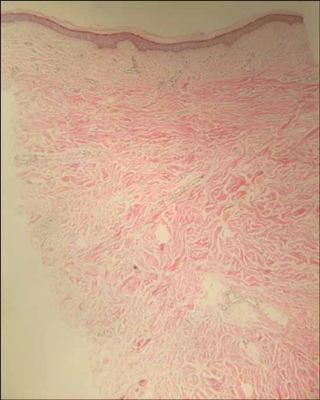Ann Dermatol.
2010 Feb;22(1):96-98. 10.5021/ad.2010.22.1.96.
A Case of Adams-Oliver Syndrome
- Affiliations
-
- 1Department of Dermatology, Busan Paik Hospital, College of Medicine, Inje University, Busan, Korea. paikderma@hanmail.net
- KMID: 2172050
- DOI: http://doi.org/10.5021/ad.2010.22.1.96
Abstract
- Adams-Oliver syndrome (AOS) is a congenital condition characterized by aplasia cutis congenita, transverse limb defects, and cutis marmorata telangiectatica. AOS can also be associated with extensive lethal anomalies of internal organs, including the central nervous, cardiopulmonary, gastrourointestinal, and genitourinary systems. Generally, the more severe these interrelated anomalies are, the poorer the prognosis becomes. In the relevant literature on this topic, it is somewhat unclear as to whether the prognosis of AOS without lethal anomalies alters the lifespan. We report a case of AOS with typical skin defects only, and no internal organ anomalies.
MeSH Terms
Figure
Reference
-
1. Adams FH, Oliver CP. Hereditary deformities in man: due to arrested development. J Hered. 1945. 36:3–7.2. Mempel M, Abeck D, Lange I, Strom K, Caliebe A, Beham A, et al. The wide spectrum of clinical expression in Adams-Oliver syndrome: a report of two cases. Br J Dermatol. 1999. 140:1157–1160.
Article3. Becker R, Kunze J, Horn D, Gasiorek-Wiens A, Entezami M, Rossi R, et al. Autosomal recessive type of Adams-Oliver syndrome: prenatal diagnosis. Ultrasound Obstet Gynecol. 2002. 20:506–510.
Article4. Narang T, Kanwar AJ, Dogra S. Adams-Oliver syndrome: a sporadic occurrence with minimal disease expression. Pediatr Dermatol. 2008. 25:115–116.
Article5. Dadzie OE, Tyszczuk L, Holder SE, Teixeira F, Charakida A, Scarisbrick J, et al. Adams-Oliver syndrome with widespread CMTC and fatal pulmonary vascular disease. Pediatr Dermatol. 2007. 24:651–653.
Article6. Sankhyan N, Kaushal RK, Jaswal RS. Adams-Oliver syndrome: a case with complete expression. J Dermatol. 2006. 33:435–436.
Article7. McGoey RR, Lacassie Y. Adams-Oliver syndrome in siblings with central nervous system findings, epilepsy, and developmental delay: refining the features of a severe autosomal recessive variant. Am J Med Genet A. 2008. 146A:488–491.
Article8. Jun SY, Khang SK, Park SH. An autopsy case of Adams-Oliver syndrome. J Korean Med Sci. 2000. 15:482–484.
Article9. Verdyck P, Blaumeiser B, Holder-Espinasse M, Van Hul W, Wuyts W. Adams-Oliver syndrome: clinical description of a four-generation family and exclusion of five candidate genes. Clin Genet. 2006. 69:86–92.
Article




